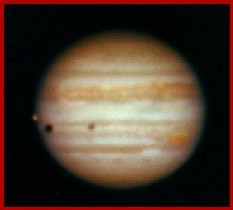Gian Domenico Cassini (continued)
Remaining in the field of Cassini's planetary studies, his
"Astronomical Almanac" of Jupiter's satellites was of particular
importance.
Finding the positions of the moons of
Jupiter allowed Cassini to prepare tables showing the moments when the
satellites disappeared behind the planet. The observation of the eclipse of a
satellite allowed him to read from the tables the exact time at which this
occurred, which gave an extremely accurate time measurement. This meant that
it was possible to determine precisely the longitude of the place where the
observation occurred, thus helping to solve one of the biggest problems of the
time.
In addition, by establishing the periods of revolution of the satellites around Jupiter, Cassini was then able to discover that the satellites were eclipsed by the planet with a short delay. This was due to the time needed for the light to reach us from the planet. Thanks to this effect discovered by Cassini and thanks to his accurate observations and his precise calculations, his collaborator Ole Roemer succeeded in 1675 in measuring the speed of light.
 |
|
| Fig. 2:
The
great map of the Moon drawn by Gian Domenico Cassini in 1679. (Credit: Biblioteca del Dipartimento di Astronomia di Bologna) |
Cassini's great map of the Moon, with
its delicate micrometric observations, achieved vast fame. These observations
allowed him to study the variations in the orbit of our satellite, which led
him to elaborate what is considered to be the first modern theory of lunar
movements.
Three laws, expressed by Cassini in
1693, arose from his research into tidal attractions between planets and their
satellites - similar to those found between the Moon and the Earth.
Verification of this has been published recently in Icarus, the most
important international journal of planetary studies.
Few scientists have had the honour
which has been bestowed on Gian Domenico Cassini – that of still being quoted
in scientific literature after more than 300 years, thanks to the current
relevance of his research and not just because of his importance in history.
|
|
(Gian Domenico Cassini -
page 4 of 4)
< Back | |

